Chapter: Cryptography and Network Security Principles and Practice : Cryptographic Data Integrity Algorithms : Cryptographic Hash Functions
Secure Hash Algorithm (SHA)
SECURE HASH ALGORITHM (SHA)
In recent
years, the most widely used hash function has been the Secure
Hash Algorithm (SHA). Indeed,
because virtually every other widely used hash function had been found to
have substantial cryptanalytic weaknesses, SHA was more or less the last
remaining standardized hash algorithm by 2005. SHA was devel- oped by the National Institute of Standards and Technology
(NIST) and published as a federal
information processing standard (FIPS 180) in 1993. When weak- nesses were
discovered in SHA, now known as SHA-0,
a revised version was issued as FIPS 180-1 in 1995 and is referred to as SHA-1. The actual standards document is
entitled “Secure Hash Standard.” SHA is based on the hash function MD4, and its
design closely models MD4. SHA-1 is also specified in RFC 3174, which
essentially duplicates the material in FIPS 180-1 but adds a C code
implementation.
SHA-1 produces a hash value of 160 bits. In 2002, NIST produced a revised
version of the standard, FIPS 180-2, that defined three new versions of SHA, with hash value lengths of 256, 384, and 512 bits, known as SHA-256,
SHA-384, and SHA-512,
respectively. Collectively, these hash algorithms are known as SHA-2. These new versions have the same
underlying structure and use the same types of modular arithmetic and logical
binary operations as SHA-1. A revised document was issued as FIP PUB 180-3 in 2008, which added a 224-bit
version (Table 11.3).
SHA-2 is also specified in RFC 4634, which essentially duplicates the material
in FIPS 180-3 but adds a C code implementation.
In 2005, NIST announced the intention to
phase out approval of SHA-1 and move to a reliance on SHA-2 by 2010. Shortly
thereafter, a research
team described an attack in which
two separate messages could be found that deliver the same SHA-1 hash using 269 operations,
far fewer than the 280 operations previously thought needed to
find a collision with an SHA-1 hash [WANG05].
This result should hasten the
transition to SHA-2.
In this section, we provide a description of
SHA-512. The other versions are quite similar.
SHA-512 Logic
The algorithm takes as input a message with
a maximum length of less than 2128 bits and produces as output a 512-bit message digest. The
input is processed in 1024-bit blocks. Figure 11.8 depicts the overall
processing of a message to produce a digest. This follows the general structure
depicted in Figure 11.7. The processing consists of the following steps.
Table
11.3 Comparison
of SHA Parameters
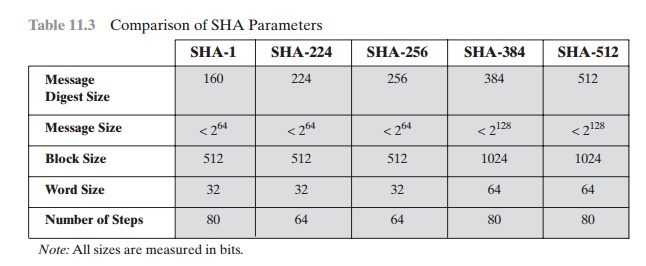

Step
1 Append padding bits. The message is
padded so that its length is congruent to 896 modulo 1024 [length K 896(mod 1024)]. Padding is always added, even if the
message is already of the desired length. Thus, the number of padding bits is
in the range of 1 to 1024. The padding consists of a single 1 bit followed by
the necessary number of 0 bits.
Step
2 Append length. A block of 128 bits is appended to
the message. This block is treated as
an unsigned 128-bit integer (most
significant byte first) and contains
the length of the original message (before the padding).
The outcome of the first two steps yields a message that is an integer
multiple of 1024 bits in length. In Figure 11.8, the expanded message is repre- sented as the sequence of 1024-bit blocks M1, M2, ….. , MN, so that the total length of the expanded message is N * 1024 bits.
Step 3 Initialize hash buffer. A 512-bit
buffer is used to hold intermediate and
final results of the hash function. The buffer can be represented as eight 64-bit reg- isters (a, b, c, d, e, f, g, h). These registers
are initialized to the following
64-bit integers (hexadecimal values):
a = 6A09E667F3BCC908 e = 510E527FADE682D1 b =
BB67AE8584CAA73B f = 9B05688C2B3E6C1F c
= 3C6EF372FE94F82B g = 1F83D9ABFB41BD6B
d = A54FF53A5F1D36F1 h =
5BE0CD19137E2179
These values are stored in big-endian format, which is the most significant byte of a word in the low-address
(leftmost) byte position. These words were obtained by taking the first sixty-four bits of the fractional
parts of the square roots of
the first eight prime numbers.
Step 4 Process message in 1024-bit (128-word) blocks. The heart of
the algorithm is a module that consists of 80 rounds; this module is labeled F in Figure 11.8. The logic
is illustrated in Figure 11.9.
Each round
takes as
input the
512-bit buffer
value, abcdefgh, and updates the contents of the buffer. At input to the first round, the buffer has the value of the intermediate hash value, Hi - 1. Each round t makes use of a 64-bit value Wt, derived from the current 1024-bit block being processed (Mi). These values are derived using a message
schedule described subsequently. Each round also makes
use of an additive constant Kt, where 0 … t … 79 indicates one of
the 80 rounds. These words represent
the first 64 bits
of the fractional parts of
the cube roots of the first 80 prime numbers.
The constants provide a “randomized” set of 64-bit patterns,
which should eliminate any regularities in the input data. Table 11.4 shows these constants
in hexadecimal format (from left to right).
The output of the eightieth
round is added to the input to the first round (Hi - 1) to produce
Hi. The addition is done independently for each of the eight
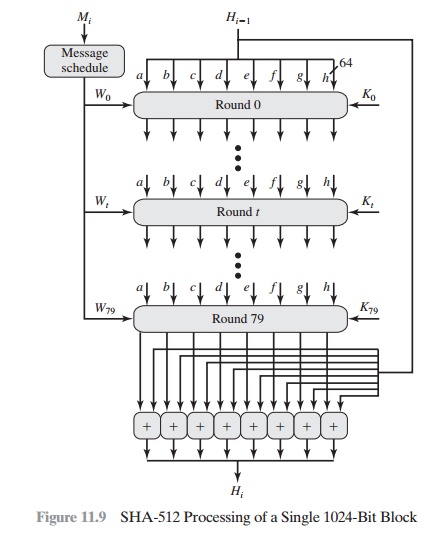
words in the buffer with each of the corresponding words in Hi - 1, using
addi- tion modulo 264.
Step
5 Output. After all N 1024-bit blocks have been processed,
the output from the Nth stage is the
512-bit message digest.
We can summarize the behavior of SHA-512 as
follows:
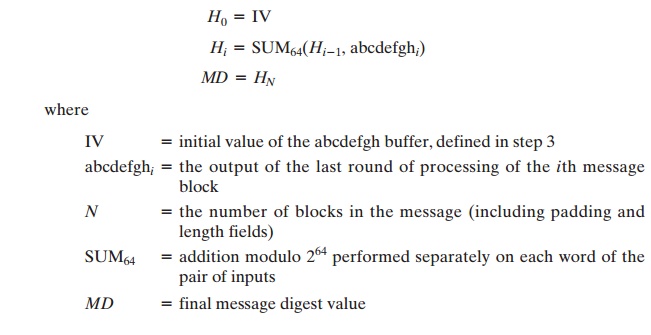
SHA-512 Round
Function
Let us look in more detail at the logic in
each of the 80 steps of the processing of one 512-bit block (Figure 11.10).
Each round is defined by the following set of equations:
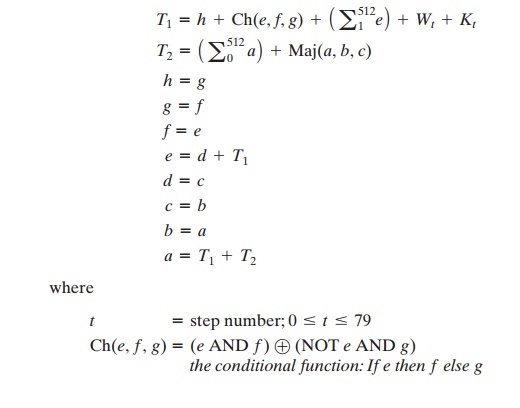
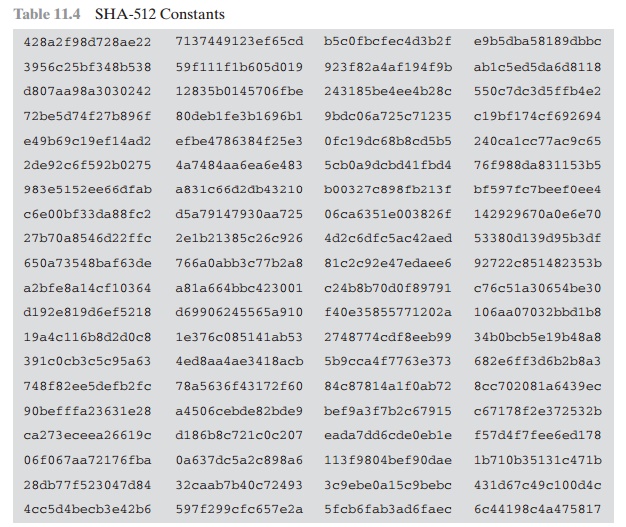
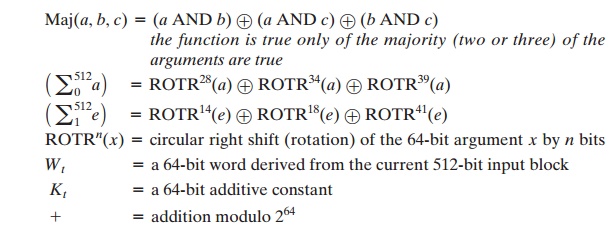
Two observations can be made about the round
function.
1.
Six of the eight words of the output of the round function
involve simply per- mutation (b, c, d, f, g, h) by means of rotation. This is indicated
by shading in Figure 11.10.
2.
Only two of the output words
(a, e) are generated by substitution. Word e is
a function of input variables (d, e, f, g, h), as well as the round word Wt and the constant Kt. Word a is
a function of all of the input variables except d, as well as the round word Wt and the constant Kt.
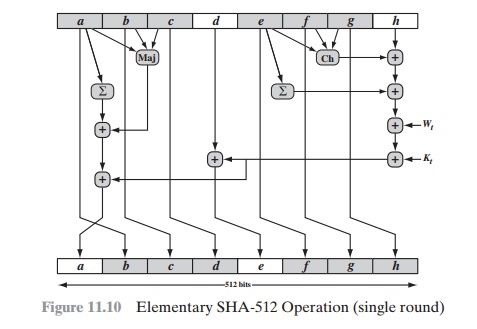
It remains
to indicate how the 64-bit word values Wt are derived from the 1024-bit message. Figure
11.11 illustrates the mapping. The first 16 values of Wt are taken directly
from the 16 words of the current block. The remaining values are defined
as
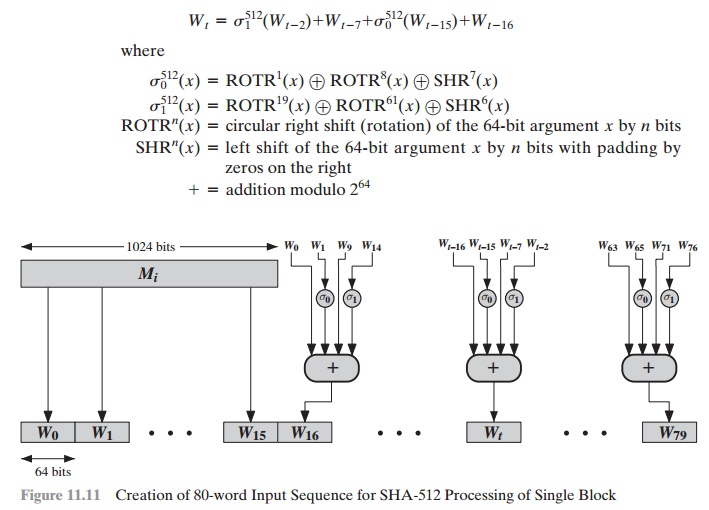
Thus, in the first 16 steps of processing, the value of Wt is
equal to the corre- sponding word in the message block. For the remaining 64 steps, the value of Wt consists of the circular left shift by one bit of the XOR
of four of the preceding values of Wt, with two of those values
subjected to shift
and rotate operations. This introduces a great deal of redundancy and interdependence into the message
blocks that are compressed,
which complicates the task of finding
a different message block that maps to the same compression function
output.
Figure 11.12 summarizes the SHA-512 logic.
The SHA-512 algorithm has the property that every bit of the
hash code is a function of every bit of the input. The complex repetition of
the basic function F produces results that are well mixed; that is, it is unlikely that two messages
chosen at random, even if they exhibit similar regularities, will have
the same hash code. Unless there is some hidden weakness in SHA-512, which has not so far been published, the difficulty of coming up with two messages having the same message
digest is on the order of 2256 operations, while the difficulty of finding a message with a given digest
is on the order of 2512 operations.
Example
We include here an example
based on one in FIPS 180. We wish to hash a one-block message consisting of three
ASCII characters: “abc”,
which is equivalent to the fol- lowing 24-bit binary string:
01100001 01100010 01100011
Recall from step 1 of the SHA algorithm,
that the message is padded to a length congruent to 896 modulo
1024. In this case of a single block, the padding consists of 896 - 24 = 872 bits, consisting of
a “1” bit followed by 871 “0” bits.
Then a 128-bit length value is appended to the message, which contains the
length of the original message (before
the padding). The original length is 24 bits, or a hexadecimal value of 18.
Putting this all together, the 1024-bit message block, in hexadecimal, is

This block is assigned to the words W0, Á ,W15 of the message
schedule, which appears as follows.
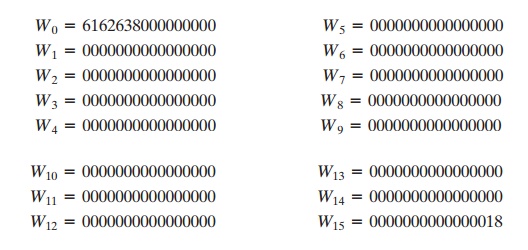
As indicated in Figure 11.12,
the eight 64-bit
variables, a through h, are initial-
ized to values H0,0 through H0,7. The following table shows the initial values
of these variables and their values
after each of the first
two rounds.
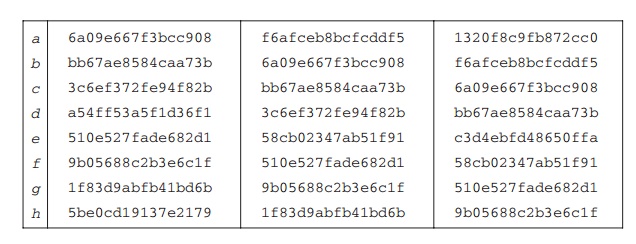
Note that in each of the rounds, six of the
variables are copied directly from variables from the preceding round.
The process continues through 80 rounds. The
output of the final round is
73a54f399fa4b1b2
10d9c4c4295599f6 d67806db8b148677 654ef9abec389ca9 d08446aa79693ed7
9bb4d39778c07f9e 25c96a7768fb2aa3 ceb9fc3691ce8326
The hash value is then calculated as
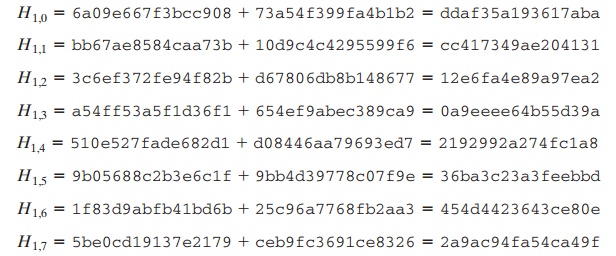

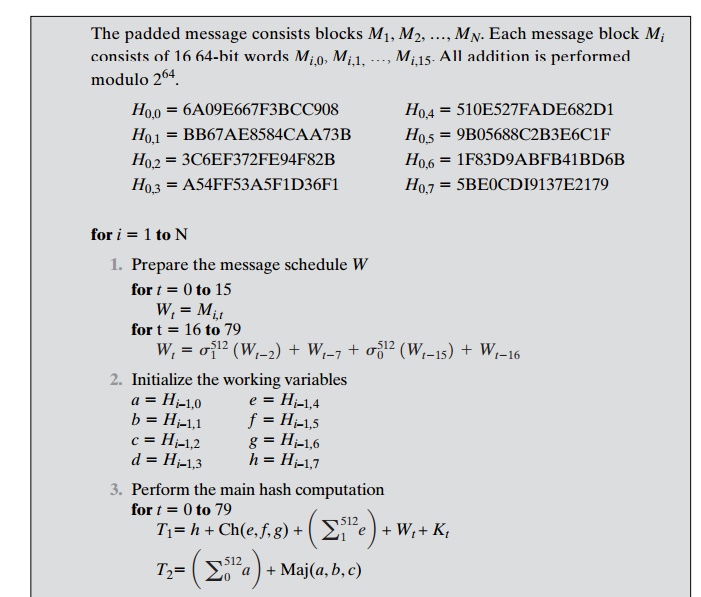
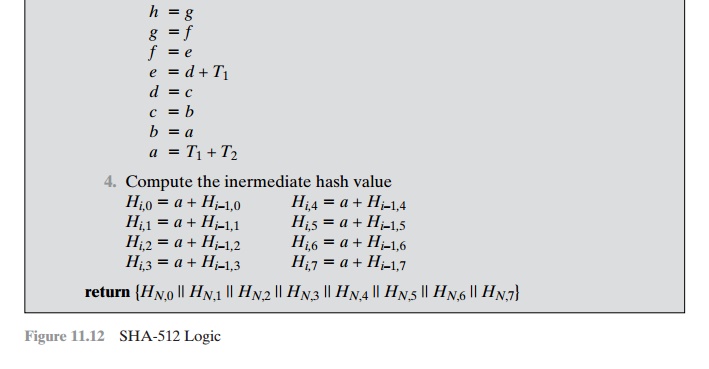
Suppose now that we change the input message
by one bit, from “abc” to “cbc”. Then, the 1024-bit message block is

And the resulting 512-bit message digest is
531668966ee79b70
0b8e593261101354 4273f7ef7b31f279 2a7ef68d53f93264
319c165ad96d9187
55e6a204c2607e27 6e05cdf993a64c85 ef9e1e125c0f925f
The number of bit positions that differ
between the two hash values is 253, almost exactly half the bit positions, indicating that SHA-512 has a good avalanche
effect.
Related Topics